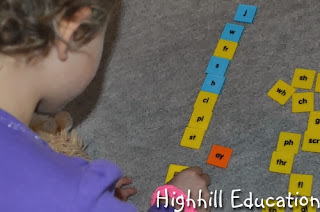Games are great for learning to read, but playing the games in a sequence that enables the child to build on existing knowledge is key. There are several steps in learning to read. Although it isn't necessary to thoroughly master each skill before moving on, sufficient knowledge of a skill set will enable the child to figure out missing information as they progress.
Many phonics curriculum methodically cover each step in this process, but they can be expensive and repetitive. All three of my children have learned to read by spending lots of time on each of the steps in the process, but without the pressure of a curriculum. Keeping children entertained and interested is more important than covering each minute detail. Practice through various activities will fill in gaps.
Teaching a child to read is so much fun. Playing games and spending time together are rewards enough to practice every day.
Here is the general process we follow to learn to read.
1. Learn letters
2. Learn letter sounds
3. Learn to read three letter short vowel words such as cat, big and hop
4. Begin reading very simple books. The School Zone books are my favorites because they are colorful, simple and entertaining.
The Fox on the Box (A School Zone Start to Read Book, Ages 4-7, Level 1)
Jog, Frog, Jog - level 1 (Start to Read! Library Edition Series)
The Gum on the Drum (Start to Read! Library Edition Series)
5. Continue to practice reading words with games, activities and manipulatives.
6. Introduce consonant blends such as br as in brat, and brim, cr as in crab, and sh as in fish and shop
7. Learn about the letters who like to go together at the ends of words; ll, ff, zz, ss and ck as in hill, off, and sack
Before Proceeding to Step 8 - kids should have a very good understanding of steps 1-7. Proceeding to Silent e too early can cause lots of confusion and frustration.
8. Learn how silent e makes the vowels say their name, for example tap changes into tape and bit changes to bite
9. Learn how when two vowels are together, the first one says its name; ai, ay, ue, ea, ei, ee, oa, and oe. For example - rain, blue, and each.
10. Continue reading simple phonics books and maybe try out some Dr. Seuss board books.
11. Learn how vowels combine with the letter r - ar, er, ir, or and ur - several sound alike and we must learn how to remember them over time and through reading.
12. Learn about silent b and silent k which do not make a sound.
13. While reading simple books discuss naughty words that don't follow the rules such as said and have.
14. Spend a day or two learning about the following unique sounds; ow, ou, igh, oo, y, aw, au, oi, oy, ew, eu, and eigh.
15. Practice reading two syllable words such as catfish and velvet.
16. Continue reading easy books such as Little Bear and Dr. Seuss. Read, Read, and Read.
Notes:
- Steps 1 and 2 are often done in reverse order or simultaneously. For us one of our favorite resources to complete these steps are the Leap Frog Videos.
- Many games on my Language Arts Page work well for steps 3-16.
- We did not practice site words. Although it's not a bad idea most of them follow the above rules and can be learned through practice.
My favorite manipulatives for learning to read are letters. Big plastic letters, magnetic letters, letter tiles, homemade paper letters, or tiles which include blends and other common sounds all work equally well.
Here's an example of one of our learning to read sessions. We got out the letter tiles and introduced the ay tile and talked about its sounds. Next my daughter selected letters or letter combinations which would make words with ay. Her list includes; j, w, h, t, s, cl, pl and st.
When doing this activity, if she selects letters that are phonetically correct but not spelled the proper way in English such as toon instead of tune - I let it go. The point is to learn the rules of reading and the oo sounds the same as u with silent e. If she continues to spell tune, toon once she has mastered reading at a much higher level, we will talk about it then.
Since this is a learning to read post I thought it proper to link up some letter tiles. If you don't have letters already this is a great set, but if you do, just use what you have. After all, the English alphabet has only 26 letters and it doesn't matter if they are printed on paper, plastic or wood. Children can learn to read from them all.

This post is linked to:
Sola Gratia
True Aim Education




Love it-thanks for linking up!
ReplyDeleteGreat post! I love how you outline the process; would have been useful a year ago for me, but we figured it out! Thanks for sharing at Mom's Library; I featured you this week!
ReplyDeleteI have read that books that employ instructional cards can further an interest in reading and language. Writing and art interests can be developed with phonics toys, erasable writing products, coloring toys and model kits, craft kits and different painting mediums. I have recently found an interesting website http://helpkidsread.net that is just awesome to have books to let your child read. Thanks and keep sharing the nice content!!
ReplyDelete